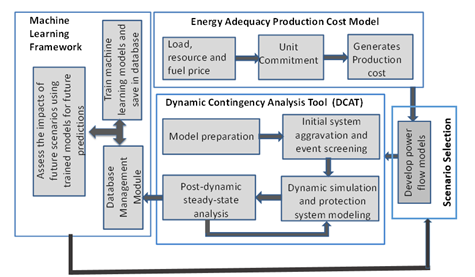Technical Approach
- Develop energy adequacy production cost model by using wind, solar photovoltaic, and load penetrations at various operating points and develop power flow models with hourly resolution.
- Enable future integration of DCAT with the industry grade big data analytical platform. To achieve this, big data should be properly handled at different layers.
- Develop advanced machine learning methods for Big Data analysis (e.g., principal component analysis to identify the most influential factors, clustering technique to group similar contingencies and identify patterns, neural network and multivariate regression to build predictive models).
- Perform steady-state and dynamic reliability studies using DCAT for a large interconnected system, identify reliability issues as load and renewable penetrations increase, and propose solutions.
- Perform “N-k” dynamic contingency analysis using DCAT for a large interconnected system and save a large amount of dynamic and steady-state data in database module.
- Use the proposed machine learning framework with DCAT database module to conduct fast stability scanning of future scenarios and intelligently identify critical scenarios that the grid operators may face in the- short and long-term planning horizons.

Lab-Level Communications Priority Topics
Grid